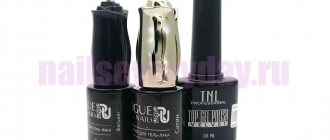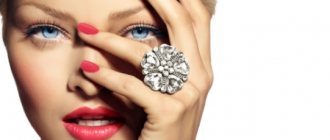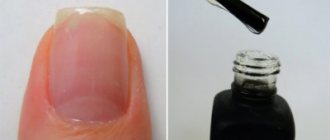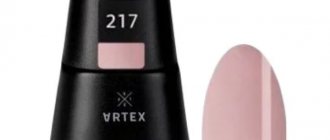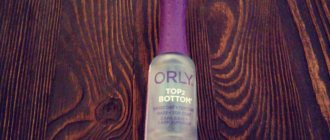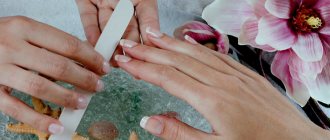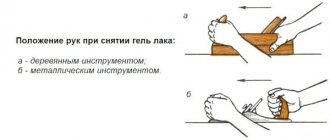To make the decorative coating on your nails look neater and last longer, it is important to follow all stages of a manicure or pedicure, as they allow you to properly prepare the surface for work, preventing premature removal of the gel polish.
Strengthening nails with gel under gel polish is one of these steps, which helps prevent mechanical stress on the plate, which can lead to its breakage. In addition, strengthening with gel compacts the decorative coating, which is why it remains in its original form longer.
What is a gel polish base?
Base - Base coat - the same as the base for gel polish - this is the first phase of a three-phase gel polish system. It is applied as the first layer to a clean nail plate and polymerized in an ultraviolet or LED lamp. This is the first and most important stage of gel polish coating, the quality of which determines the durability, duration of wear and safety of growing nails. The quality of the base coating is determined not so much by the cost of the material, but by its correct selection according to certain characteristics, in accordance with the individual characteristics of the nails of a particular person.
Removing reinforcing fabric
Removing the reinforcing fabric is as quick as attaching it. To do this, you will need a file with an abrasiveness of 180/220 grit, as well as liquid for soaking gel coatings.
Using a buff or file, you need to remove the top glossy layer from the plate, and then moisten it in removing liquid; cotton glue can be removed with an orange stick.
Bio-reinforcement of nails is a useful procedure that increases the strength of the plate with natural materials or hides visible damage. The result is beautiful, well-groomed hands in 15 minutes.
Why do you need a gel polish base?
The initial task of the gel polish base is to ensure adhesion of the color coating to the natural nail plate. But, firstly, this function is far from the only one, and secondly, different types of databases cope with it in different ways.
What a gel polish base can do:
- improving the adhesion of colored gel polish or gel to the keratin of the nail plate,
- smoothing the surface of the nail,
- strengthening and protecting the natural nail,
- tinting the nail plate (camouflage),
- extension of nails and repair of broken corners,
- fixing rhinestones and volumetric decor,
- fixing sliders and rubs,
- execution of designs “on wet”,
- mixing with dry pigments and glitter, diluting colored gel polishes, etc.
Gel polish bases can be classified according to several unrelated criteria:
- Consistency (thickness) in a liquid state
- Plasticity after polymerization
- Adhesiveness (stickiness)
- Polymerization temperature
- Pigmentation
There are different combinations of these signs. First, let's look at what each of them provides separately.
Removing artificial material
Protective coatings can be removed using liquid solvents or mechanical sawing. To remove artificial materials, special solvents based on isopropyl alcohol have been developed. If you urgently need to remove the gel at home, you can use acetone. Cotton pads are soaked in solvent and applied to the nails. You can cover the top with food foil. After 15-20 minutes, the “caps” are removed from the nails. The loose material is carefully removed with an orange stick. After removal, it is advisable to moisturize and nourish the nails and cuticles with oil or cream.
Consistency: liquid, medium and thick base for manicure. What is more convenient and for what?
| Liquid | Medium (3-6 sec) | Thick (7-infinity) | |
| Leveling speed | 1-2 seconds | 3-6 seconds | from 7 seconds to infinity |
| Layer thickness | + Thin or rubbing - Large volume spreads, loses shape and forms streaks | + Middle layer (about 0.5mm) — A thin layer is applied slowly — A thick layer may spread and lose its shape in the lamp | + Thick layer (up to 1mm) - Does not level out with a thin layer, forming bumps |
| Which nails? | + Very short with minimal alignment + For arched (convex) nails + As a strengthening base for soft, sawn, long nails | + Medium length nails + Arched nails that require a little straightening — On too short and very long ones, the time spent on coating increases | + Long nails when volume is required + Flat nails without their own longitudinal and transverse arches - to create architecture |
| Who is it suitable for? | + An experienced master with developed motor skills, from whom the material “will not have time to escape” | + For beginners in the manicure business + For “selfies” - those who do their own nails at home and don’t see the point in buying many different bases | + An experienced craftsman who can quickly lay out thick material and help it level out |
| Additional features | Attaching sliders, rubbing, glitter, wet-on-wet designs | It forms a layer that is either too thick for rubbing and glitter, or too thin and spreads when attaching rhinestones or extending them. | Fixing rhinestones and voluminous decor Extending and repairing broken nails |
Liquid base for nails
The liquid base is quickly and easily applied to the nail in a thin layer, but spreads in a thick layer. It works best when covering short or convex nails without leveling. On long or injured nails, it is often used as a thin substrate under a reinforcing layer of hard material, which is laid out with a thick base, gel or acrygel (polygel). Also, “flowing” designs are made on such a base, and rubs, sliders and glitter are attached to it.
Thick nail base
You need to apply the thick material to the nail plate slowly and carefully so that it has time to transfer from the brush to the nail. Thick gels lay down unevenly in a thin layer; for a beautiful, even coating you have to add additional volume using the leveling technique. A thick base is suitable for any nails, but is most convenient on long or flat ones. If, after polymerization, such a material becomes hard and inelastic, then it can be used for strengthening and repair.
Medium thick manicure base
We recommend medium-thick bases for those who regularly do their own manicures, do not grow them to extreme lengths and do not bite their nails at the root, and are also not interested in creating a portfolio of selling photographs. Almost anything can be done with such a base, but slowly, which is rather a plus for “yourself”, as it increases the degree of control.
How to understand when purchasing whether the base is liquid or thick
When purchasing, you can find out how liquid the base is and how quickly it levels out in the following way: open the bottle, carefully take out a brush with a drop of material and see how long it takes for this drop to take a spherical shape and separate from the brush. Liquid materials drip almost instantly, medium ones take 5 to 7 seconds, and thick materials may remain on the brush.
Liquid and thick bases are produced for nail service professionals to solve specific problems. The choice must be made taking into account other properties, which will be discussed below.
How to choose a base for different types of nails
In fact, there are no bad or good bases; there are bases with different physical properties and purposes. It is important to use them correctly. The fact is that each person's nails are unique in their own way. The master’s task is to understand which nails are in front of us and to choose the right base for these very nails.
For example, it is not advisable to apply liquid bases to thin nails, because... They become very hard when cured. As a result, the native nail under the coating may bend or deform, but the hard coating cannot. Therefore, the coating begins to chip and peel off.
On thin nails it is better to apply a rubber-based base. After hardening, such a base can bend slightly along with the natural nail - this will allow you to wear the coating longer.
When the client comes next time, everything is simpler: we see the results of wear and the choice of base becomes obvious. We carefully examine the nail to see if there are any detachments or chips. Where do they start from the cuticle or the end of the nail. The identified problems are like a map that shows us the structural features of these particular nails.
Plasticity: hard (hard), reinforcing and elastic (soft) bases
| Elastic (soft, flexible, soak off base) | Medium and reinforcing (strong, fiber) | Hard (hard, builder) | |
| For which nails | Suitable for short, thin, soft nails | For healthy nails, medium length | Suitable for strong nails To strengthen long nails |
| Layer thickness | Thin — Those applied in a thick layer peel off | Medium or thick They vary in hardness from different manufacturers, we adapt the technique | Thick (up to 1mm) — Applied in a thin layer, they chip |
| Additional features | + Adhere well to the mobile, soft nail plate | + Fiber - bases contain fiberglass and are reinforced — In the sock they sag in the stress zone, longer lengths are not strengthened — Short nails peel off if there was a leveling layer | + Maintains length and shape, does not sag in stress zones, therefore suitable for extensions and repairs |
| Removal methods | Dissolved with acetone, carefully cut down with a red ceramic cutter | Slowly dissolve with acetone The main volume is cut off with a blue cutter; if necessary, the remaining thin layer can be dissolved | They do not dissolve. They are cut off with a blue or green TVS cutter, about 5% remains on the nail. |
Elastic (soft, flexible, plastic, flexy, soft, soak off base) base for gel polish
They dissolve in acetone and can be completely removed by soaking. Worn for up to 3-4 weeks on short, soft, thin nail plates. They can be slightly more or less flexible and have different consistencies: from liquid like water to thick like cream, that is, consistency does not affect elasticity. But it is important to know that elastic gel polish materials, when applied in a thick layer, peel off, which means it is preferable to apply a thin coating with them and choose a consistency closer to liquid. Extensions, strengthening and repairs are not done with soft gels.
Solid (hard, constructing, hard base, builder base) base for gel polish
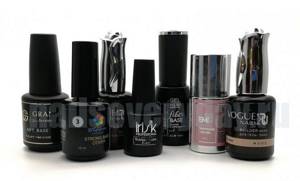
An insoluble base that is cut off with a milling cutter or file. Similar to extension gel, but a little thinner and comes in a bottle with a brush. A hard base is needed to strengthen long, weakened natural nails, repair and extend them. Retains its laid out shape and provides protection from external mechanical damage. When applied in a thin layer, the natural nail plate cracks and chips, so masters choose gels with medium or thick consistency that hold the laid out volume.
How to check if the base is hard or soft
If you have some kind of base in your arsenal, but you don’t know how hard it is and whether it is suitable for strengthening, then finding out is quite simple. Apply the material to the film in a stripe, leveling layer (up to 1mm thickness) and polymerize. After drying, separate from the film and try to bend it. If the base wrinkles and curls easily, then it is elastic. If it cracks and breaks quickly, then it’s tough. You feel an elastic, but hard material that neither bends nor breaks - what you see is a reinforcing base that is closer to solid.
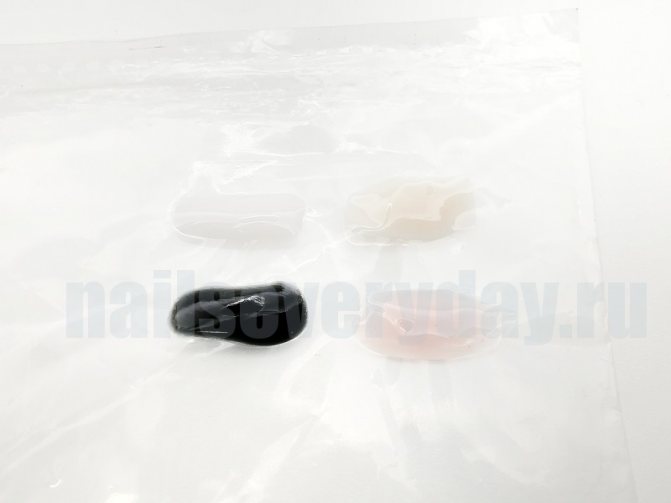
We apply the bases as a leveling layer on a thin film and polymerize. Degrease and remove from film.
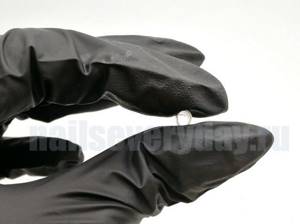
Bend and twist the base. A very soft base rolls up into a roll.

The elastic rubber base is more resilient.
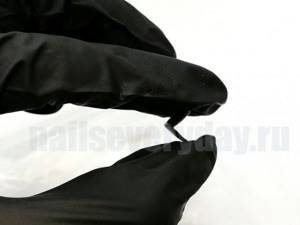
The hard but resilient black rubber base only flexed when pressed hard. But it didn’t crack, which means it’s suitable for strengthening.
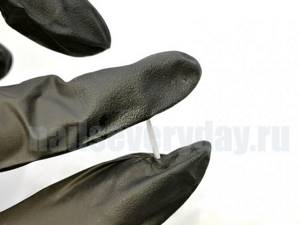
The rigid base never bent, but it didn't crack either. Durable material suitable for extensions.
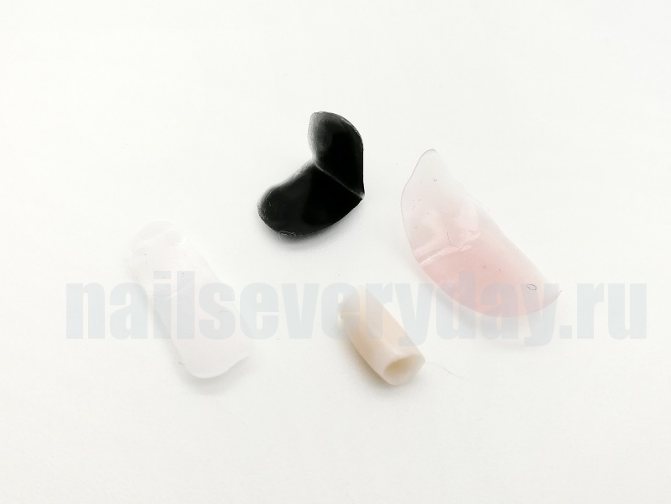
We see how different bases are deformed after loading.
Reinforcing base or base with fiberglass (fiber base)
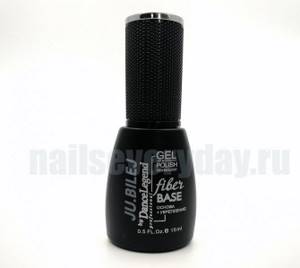
A strong but flexible base to which pieces of polyester or "fiberglass" are added. They may be clearly visible or look like thin fibers, or they may not be visible at all to the naked eye. Fiberglass plays the role of a reinforcing frame around which the polymer is built. The elasticity of such bases varies greatly, as does the consistency. Materials that are average in all characteristics are suitable for thin, soft nails of short and medium length. Sometimes there are also more solid fiber bases, which can be used for strengthening and repairs. You can find out what properties a particular product has on the website of its manufacturer.
So, we recommend using a thin layer of elastic bases on soft and mobile nails. If they are also long, then reinforce the dried thin layer of soft base with a thicker, leveling layer of hard base (or gel/acrygel). Without a plastic backing, hard bases can only be applied to strong and healthy natural nails.
Base for gel polish for pedicure
In pedicures, it is allowed to use only elastic materials and apply them in the thinnest possible layer, without leveling or strengthening. That is, only elastic and not thick bases. This is due to the stress that toenails experience even without coating. A thick layer of hard material, especially during the season of closed shoes, provokes the formation of subungual calluses, onycholysis, curling of nails and inflammation of the lateral ridges. During the cold season, a reasonable solution would be to avoid gel polish on your feet altogether and, if desired, do a pedicure with regular polish.
Content
- Strengthening with acrylic powder under gel polish
- Strengthening with biogel under gel polish
- Strengthening with a base for gel polish
- Strengthening with gel under gel polish
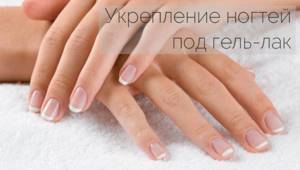
However, not everything is so simple.
- Firstly, gel polish does not have any therapeutic effect on nails , so the effect of strengthening nails lasts only while wearing it. This can be used to grow your nails a little longer if they don’t look very presentable right now.
- Secondly, many complain that after removing the gel polish, the nails not only become stronger, but, on the contrary, become thinner , brittle and look even worse. But here, rather, the complaints should not be about the gel polish, but about the process of removing it: if you peel it off yourself, scraping it off with your nails, then it’s quite likely that everything will be like that. If you use the correct removal methods (by soaking in a special liquid or using a cutter), then such problems cannot occur.
Strengthening under gel polish is done using acrylic powder and biogel; the base can help a little with this, but the gel is used for slightly different purposes. Next, I will talk about the nuances of each of these options.
Adhesiveness: why does gel polish stick to nails?
Acid bases for manicure
The adhesion of the gel polish base to the nail plate is greatly affected by the acidity of the material. The more methacrylic acid in the composition, the more the material dries the outer layer of the nail and the better the adhesion. Many manufacturers are silent about this aspect of the issue and do not publish data on the pH level due to the fact that too frequent use of an acid base and severe drying leads to curling and brittleness of the natural nail, which will scare off buyers. You can independently check the pH level of the material using litmus paper. Bases with a pH level of around 5-6 are considered safe, 3-4 are considered medium acidic, and below 3 are considered strongly acidic.
Safe bases adhere well to healthy nails, but for damp, thin and worn nails you should choose medium-acid bases. Avoid using acidic materials too often if you do not want to at some point lose your natural nails due to their curling and brittleness and be forced to switch to extensions. Also, within a few days, the acid base can dissolve the pigment of the colored gel polish applied on top of it, which will cause yellowish spots visible to the naked eye. If you do use an acidic base, rub a thin layer of it into the nail and remove the stickiness from it before applying colored gel polish (or cover it with a less acidic one on top).
Rubber base (rubber base)
The adhesion of the gel and nail at the molecular level can be improved due to the presence of special components in the material that form strong bonds with keratin. Such materials include rubber bases . “Rubber” was initially positioned by manufacturers as “stickiness”, good adhesion, and not as elasticity and at the same time strengthening, as many have probably already heard somewhere. There is no natural rubber in the composition, but there are synthetic components with similar properties. Such bases should be applied in a thin layer, just like acidic ones, and strengthening should be done with solid materials in the second layer.

Some rubber bases will be soft, some will be harder; you can find information about this on the manufacturers’ website or on social networks, as well as in courses and in communication with craftsmen. They can also be quite acidic, medium or thick in consistency. If you are uncomfortable applying a thick base in a thin layer, it takes a lot of time, then get a separate brush for applying it: synthetic, oval, size 4-6 and quite hard. Application with such a brush will be quick and convenient.
Acrylic powder: what is it and what is it for?
Acrylic was originally used in dentistry to create fillings and dentures. And then this plastic, but at the same time durable and lightweight material was used in the nail industry. Today, manicurists use it to strengthen and extend nail plates and create various designs.
Acrylic nail powder is a polymer powder, most often based on methacrylic acid ester - ethyl methacrylate. Thanks to its properties, the powder hardens under the rays of a manicure lamp or upon contact with a special hardening liquid - monomer.
Benefits of acrylic powder
- is hypoallergenic, suitable for almost everyone. Allergic reactions occur in only 5% of cases;
- easy to use, does not require much time;
- It is characterized by increased durability, therefore reducing the risk of nail breakage.
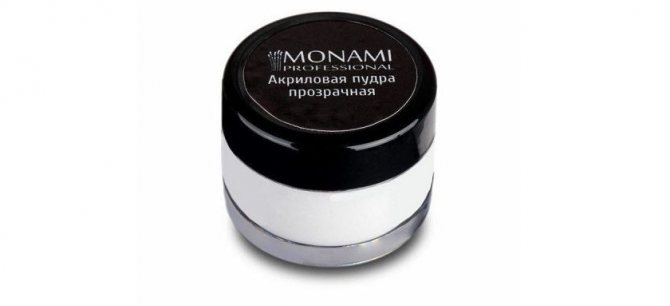
Disadvantages of acrylic powder
There is an opinion that acrylic negatively affects human health. Is it so? The material itself is absolutely safe. Its vapors are harmful. But their toxicity persists only until the acrylic dries, that is, literally a few minutes. Another small minus is that the material has an unpleasant, pungent odor. How to get rid of these shortcomings? Wear a mask and work in a well-ventilated area.
In what cases should acrylic powder be used for strengthening?
- Nails are weak and often break because of this;
- Artificial turf lasts less than a period of time; detachments, cracks, and chips constantly occur.
It should be remembered that acrylic powder does not heal the nail plate. Strengthening occurs due to the creation of an additional protective layer.
Contraindications to the use of acrylic powder are:
- fungal diseases;
- individual intolerance to components;
- undergoing chemotherapy;
- taking antibiotics.
Polymerization temperature: hot and cold bases for gel polish
All materials in the gel system emit heat when polymerized in a lamp. This is due to the chemistry of the process and the formation of polymer bonds; it is almost impossible to avoid this effect. The rate of polymerization is directly related to the amount of photoinitiators - special substances in the material that, under the influence of ultraviolet radiation, trigger a chain reaction. The faster the polymerization reaction occurs, the more heat is released per second, the more strongly it is felt. If your nails are naturally thin or injured, then during the polymerization of a thick layer of base you may feel a burning sensation that occurs almost at the very beginning of drying and goes away when you remove your hand from the UV lamp. In principle, this is a normal phenomenon and you should not be afraid of it. With high sensitivity, you can reduce the power of the UV lamp (if there is such a function) or remove your hand a little in advance, before it becomes impossible to tolerate.
For those women who value maximum comfort during the procedure, the industry offers special “cold” bases and gels. They hardly heat up, require more drying time and the application of a thin substrate under them from a regular, “hot” base, since they often have rather poor adhesion. But you don’t have to worry about the risk of thermal burns to the nail bed on thin or injured nails.
Causes of brittle and peeling nails
Before you begin the plate restoration procedure, you need to understand why breakages and detachments occur. This will help the master select the appropriate material for reinforcement and predict the future date of correction.
External reasons
Most often, weakness and fragility are associated with dehydration of the horny plates, which is caused by a number of external factors:
- constant contact with chemicals (household and alkaline products, hot water, acetone, alcohol-containing substances, etc.);
- coating of nails with gel and low-quality varnishes, which contain formaldehyde;
- incorrect removal of tips, acrygel or gel polish;
- exposure to dry or cold air;
- mechanical damage (bruises, matrix injury, sawing of the bed, occupational injuries in musicians, etc.);
- insufficient hand care.
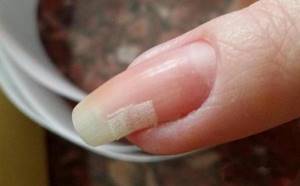
Internal reasons
It happens that nails begin to delaminate and break regularly due to internal reasons:
- iron deficiency;
- disruption of the gastrointestinal tract;
- lesions and diseases of the skin (eczema, psoriasis);
- unbalanced diet, vitamin deficiency;
- hormonal imbalance;
- pregnancy and the period after pregnancy.
Note! If the causes of failure are internal, the reinforcement will only have a cosmetic effect. After removing the material, the plate will remain weakened.
Psychological reasons
Sometimes the condition of nails worsens for psychological reasons:
- onychophagia (uncontrolled biting);
- onychotillomania (obsessive desire to scratch, tear off, destroy the nail with various objects);
- habit of tapping on hard (especially glass or metal) surfaces;
- stress, neurosis, depression.
It’s useful to know, read: - What is arch modeling?
Pigmentation: camouflage and color bases
Manufacturers in the nail industry over the past three years have moved away from the understanding of gel polish bases as a transparent product, applied in a thin layer and needed only to improve adhesion. Today, both among artists and clients, pigmented bases, which are applied using the leveling technique, are very popular. This gives sufficient color density and a beautiful, smooth surface with a relative acceleration of the procedure. Nude shades (pinkish, nude, milky, beige) of camouflage bases provide hands with a well-groomed appearance, grow unnoticed and do not attract attention. Bright colored bases, along with bases with added shimmer, gold leaf, flakes and even dried flowers, have become a hit in 2022. When covering your nails with pigmented bases, you should remember several important nuances.
Features of working with pigmented bases
- for good adhesion and subsequent safe removal with a cutter, a thin layer of transparent base is required,
- the denser the pigment of the material, the thinner the layer so that it dries completely in the lamp,
- on long nails the color base should be applied in 2 medium leveling layers,
- It is advisable to choose materials that are hard after polymerization and strengthen the nail for leveling.
As you can see, there is no need to talk about any significant acceleration of the master’s work with these technologies. But they expand the capabilities of professionals in nail decoration. It is popular to create aquarium designs and stone-like textures that are “light” in visual perception.
Of the camouflage ones, a milky base will definitely come in handy: it looks beautiful in itself, and allows you to create even a bright design on it, and will serve as a dense background for neon or “harmful” pastel shades. Natural pink and white-flesh pink camouflages are also very popular among customers. Of the colors that attract attention are mint, blue, and coral shades. The black base also makes it easier to apply translucent dark shades and is a good base for chrome rubs and cat eye gel polish.
Strengthening nails in the salon - what is it?
Strengthening nails in the salon means using extension gel, acrylic, powder or biogel under a colored coating, but not only. There are also procedures that have a therapeutic effect:
- Lamination. Includes preliminary preparation, that is, hygienic manicure, hand massage. Then vitamin serums and oil extract are rubbed into the nails. They are coated on top with a nourishing composition in the form of varnish so that the beneficial substances penetrate into the thickness of the plates and are not washed off. It also serves as protection from external influences. And on top of the laminating composition you can apply gel polish.
- Sealing. The procedure is similar to lamination in that nutrients are also rubbed into the nails. These are oils, waxes, vitamins, mineral pastes. They restore the legs and form a protective film on them. But design is not done with gel polishes after sealing.
- Hot manicure. This is a hand bath with herbal, oily vitamin solutions, creams, serums. A constant temperature is maintained in the container during the procedure, which enhances the effect of beneficial substances. After this, you can make a color coating.
- SPA manicure. This is a complex procedure that includes hygienic nail treatment, scrubbing, baths, and massage. The effect is directed not only to the nails, but also to the hands.
- Paraffin therapy. The substance is melted in a special bath, the hands are prepared by scrubbing and massage. Oil, mask or cream is applied to them and to the nails. Hands are dipped into melted paraffin three times, allowed to dry a little, and the hands are wrapped in polyethylene and thicker fabric. After 20 minutes everything is removed. Hands are washed and cream is applied.
Strengthening compounds will help extend the wearing of the design for up to 3 weeks, after which correction is needed. Otherwise, the problems that caused the need for their use will worsen. And in order for the nail-strengthening composition to lay more evenly, you need a high-quality hygienic manicure.
Which gel polish base to choose?
For those who do their own nails, as mentioned above, you can choose a medium-thick base, which is convenient. If there is no need to reinforce a large length, then a medium or reinforcing base is suitable in terms of hardness - strong and elastic. Medium acidity, rubbery, transparent.
For masters, you must have at least two databases:
1. Liquid or medium-liquid, elastic, with good adhesion.
2. Thick or medium-thick, firm, moderately hot.
In this way, the master’s basic needs will be covered in ensuring durability, strengthening, correcting imperfections of natural nail plates, and fixing various decors. It is better to choose hard camouflage bases, as well as colored ones, so that you don’t have to separately strengthen your nails with another material and waste time doing so.
Who is it shown to?
Many people are familiar with the problem of growing their nails after removing artificial ones - as you know, this is a rather long and painful process. The nail becomes brittle, can tear and becomes very soft. In this case, bio-reinforcement of nails is the best option.
This procedure will also provide invaluable assistance if the nail is damaged or a crack appears; as a rule, in such cases you want to preserve the nail and maintain its length.

Frequently asked questions or FAQ for beginners
What happens if you apply gel polish without a base?
Depends on how sticky the colored gel polish is, how healthy the nails are covered, whether it's a manicure or pedicure. When the gel polish is sticky enough to cover your toenails, there probably won’t be much of a difference in wear. Nails on the lower extremities are stronger and experience less mechanical and chemical stress, so the coating can last for a month. If you apply colored gel polish without a base to the long nails of the right hand of a person whose work involves working with his hands in a humid environment: a hairdresser, florist, cook, etc., then this coating will last only a few hours and will soon come off as a thin film. Therefore, if your colored gel polish involves a three-phase system, it is better not to experiment and not violate the technology.
What is acid-free nail base
Bases that contain an acceptable minimum of methacrylic acid and whose pH is around 6-7 are called acid-free. Such bases can ensure the wearing of artificial material for a period of no more than two weeks and only on healthy, strong nails. But they are less likely to provoke allergies on the periungual ridges and dry out the nail plate less.
Solid base or gel for extensions: what is the difference?
The difference lies in the name, packaging and polymer density. As a rule, the base is bottled in glass bottles with a brush, and the gel is bottled in round jars without a brush (but it also happens vice versa). A thick hard base and extension gel have approximately the same consistency, but the base can be much thinner and the gel much thicker. Premium, high-strength construction gels after polymerization have a denser molecular lattice and are more economical in consumption. To strengthen extremely long nails or fully extend long artificial nails, it is more reliable to use gels.
What is a hypoallergenic nail base?
This gel polish base has a slightly acidic pH and does not contain rubber. The basis for it is, like extension gels, polyurethane. In addition, the quality of the raw material and the degree of its purification are important, which affects the cost. For allergy sufferers who do not want to give up a long-lasting coating, we recommend trying premium gels certified for sale in the EU.
How to improve the adhesion of the base to the nail plate
It is necessary to thoroughly clean the surface of the nail from pterygium, remove the hydro-lipid mantle (shine) with a buff and a degreaser to wipe off dirt and cosmetic residues. If your hands are wet, apply a dehydrator. If your nails are weak, injured, and the gel polish base contains little methacrylate, then apply an acid-free primer to the stress area and the free edge of the nail.
Base and top must be the same brand
No, this is not necessary. But, if the top is elastic, then the top must also be elastic, otherwise it will crack and chip when worn.
Flexible rubber base
The most popular salon option. It can also be called “alignment”. With this method, the master uses a drop of material to build a wearable nail architecture with thickening in the stress zone (where the nail bends and can break).
To whom? This pattern is well suited for short nails, especially those that are naturally soft and flexible. It fits well on an oval shape, but on a square and around it it can fail - it does not give rigidity to the corners.
Cheap nail hardeners
Natural nails can look good even with cheap products. This is what strengthening manufacturers say. They promote rapid growth and prevent delamination. The varnish additionally forms a protective coating from external negative factors. It is advisable to apply it periodically. Nails need a break from chemical components.
Used like a regular varnish. You can first make a bath to soften the keratinized areas. Then use a special device to remove the cuticle. The hardener will be more effective if you pre-treat the nails with a solvent. This way you will degrease the area.
Nail care products at an affordable price do not perform as many functions as expensive ones. And their composition is much simpler. But, nevertheless, with their help, the nails will still receive a complex of useful substances.
Advantages
- Protects nails.
- Gives a glossy shine.
- Suitable for growing natural nails. Prevents delamination.
- Contains calcium and other microelements.
- Easy to apply with a brush.
- Acceptable price.
Flaws
There is no narrowly targeted action, like expensive products.

